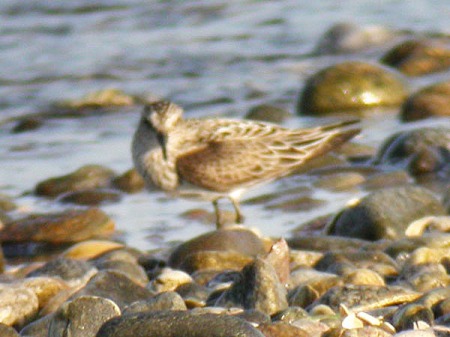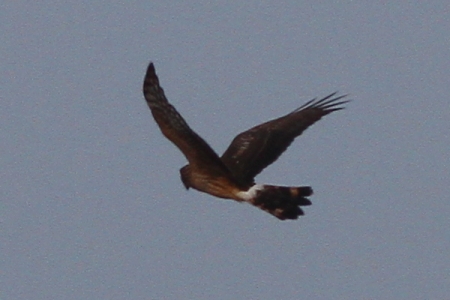
In bright sunlight, colors and subtle buff hues in the supercilium where burnt out. Note the somewhat robust appearance with diffuse brown streaks extending down past the red flanks. The legs are pinkish-horn with darker brownish toes which are pro-coburni. Nominate Eurasian iliacus usually have paler, more flesh-pink tarsi. The “tooth” shaped white tip to the top tertial and pointed rectrices age it as a SY.
The last time I was in Portland, Maine was in January 1997. It was one of my first winters in New England after migrating here from the UK. I saw an Ivory Gull. It was fantastic. A rare denizen of the ice floes of the Arctic north it performed as they often do – with unabashed boldness that belied its appearance.
I nearly made it to Portland again in the winter of 2018; on a half-hearted sojourn to see the Great Black Hawk that had put Portland back on the avian map once again. Late in its stay, this resident of Central and South America had become difficult and unpredictable. So we paused to bird at Salisbury, Massachusetts, but with no news by noon, we turned around and headed back to CT, only to hear news of its reappearance as we crossed the Nutmeg state line. Too late now. The bird was taken into captivity soon after and succumbed to frost bite. A sad event, but the squirrels of Dearing Park were reported to have uttered a combined sigh of a relief.
So, with news of a Redwing (a Eurasian thrush) being found at Capisic Park, Portland Maine, by Brendan McKay on the afternoon of 29 Jan 2021, it galvanized a few local CT birders into Twitch Mode. It was a yard bird for me, albeit in my hometown of Bolton, UK. In my boyhood days on the Isles of Scilly, I had scoured flocks of Redwings, Song Thrushes and Fieldfares looking for something rarer, like an American Robin. Now I spend my time scouring flocks of American Robins looking for Fieldfares, Redwings and Song Thrushes. Somebody’s havin’ a larff!
So, since I had not seen one for many years, it would be rude not to go check it out, if only to perform a meditative overhaul of my COVID-induced isolation. And…there was a chance it might be from the Icelandic population coburni, a subspecies tick for me.
Nick Bonomo, Glenn Williams, Dave Provencher, Anthony Viccarelli, Jason Rieger, Phil Rusch and myself, masked up and socially distanced, arrived to find the bird on-show immediately. That’s how I like my rare birds these days – UTBBB (Under the belt before breakfast).
It was associating with a flock of American Robins, apparently attracted to the sumac and multiflora rose fruit in the park and was performing well at close range in nice sunlight. It was a bit of a pain initially, in that it would always be obscured by twigs and branches, but on the odd occasion, it did manage to find itself out in the open for some nice photo opps.

In shade, the upperparts showed the darker, oily-look to them and the subtle buff tones to the fore and rear of the supercilium became a little more obvious. Here the underparts look more heavily marked with darker centres with diffuse brownish edges fitting coburni.

The feathers of the vent have large dark centres, recalling a Black and White Warbler, a feature noted by Garner et al. as pro-coburni.
Strangely enough, with no recent Redwing experience with which to compare, it did appear to be a robust individual, appearing closer to American Robin in size, with a big bill and sturdy legs. Not as dark below as some coburni, it was nevertheless an interesting bird showing several traits of Icelandic Redwing more than the nominate European iliacus. In the bright sunlight, it looked bright with a whitish supercilium, and pale mid-belly, but when the bird retreated to the shadows and out of the bright sunlight, it looked a darker, more oily-olive brown color above, with more diffuse brown feather edges to the dark brown streaking that extended way down the flanks beyond the reddish breast sides. The most compelling feature for me was the dark-centered undertail coverts which are described as being typically paler and less well-marked in iliacus. This was a feature mentioned in my old friend Martin Garner’s excellent Birding Frontiers Winter Challenge book.
When I returned home, I had some good discussions with local birder Louis Bevier, and then I reached out to sharp Icelandic birder Yann Kolbeinsson who replied, “To me there is little doubt, this has to be a coburni. Bulky looking bird with darkish legs, heavy streaking on breast (not in the heavier end) but more importantly brown base/streaking down alongside the flanks beyond where the red stops. The streaks also being more arrow/droplet shaped than actual streaks.”
Ebird Checklist with more pix:
https://ebird.org/checklist/S80340150
There is some obvious individual variation between the races, but this bird seems to fit within the paler end of coburni and would not fit a typical iliacus. For example, here’s a bird from Vancouver in Jan 2016 that is classic iliacus on plumage and would be the expected race to show up on the west coast of North America.

Note the greyer-brown tone to the small amount of upperparts we can see, coupled with the whitish ground color to the breast and unmarked belly. The dark streaking breaks up into small delineated droplets on the flanks. Note also the relatively whitish vent. Again, there is variation within iliacus with birds being more heavily marked, but had this bird shown up in eastern North America, it would easily be assignable to iliacus rather than coburni.
After our fill, we searched briefly for the western Black-headed Grosbeak that had been frequenting the park. It was the presence of this vagrant that had been the catalyst for the Redwing being found, but we drew a blank, but managed to see a wintering Dickcissel nearby with a flock of House Sparrow.
Then it was off to Arundel Cemetery, spending time en route looking in vain for Pine Grosbeak, a lifer for Jason. We soon arrived at the cemetery and found the flock of feeding Red and White-winged Crossbills. They weren’t as photogenic as we expected, but it was cool to see these niche-feeders plying their cone-destroying trade. It was at this point that we got an unexpected first for Maine – one that wasn’t on anyone’s radar I don’t think. Crossbills had been calling all the time we were there, and just as we convened to leave, the crossbills flushed in one group, giving their flight calls. Immediately one bird’s call stood out. It was a Type 4 Red Crossbill! The first recorded in Maine. Woot!! In that moment, Nick Bonomo deserves full credit for having the presence of mind to keep his phone running so he was able to capture the call. We weren’t sure if it was Type 4 or perhaps Type 3, both seemed quite similar, especially when trying to compare the timbre of calls from different quality of recordings with real-world audible experiences. Tom Johnson quickly provided us with calls from a fly-over in New Jersey, but still it was hard to decide for sure which Type we had heard, although we suspected, and hoped it would be Type 4, which Nick later confirmed by audio-spectrographic analysis.
Info here:
https://ebird.org/checklist/S80340831
Yeah, I know. You were expecting something sexier! Me too!
Jeff Groth’s landmark work in 1993, laid out the idea that each taxon gives a unique, identifiable call type when in flight. As many as 10 “call types” of Red Crossbill can be found across North America (Groth 1993, Benkman 1999, Irwin 2010), each of which may represent a different incipient species (Parchman et al. 2006).
More great in-depth and helpful info on Crossbills by Matt Young and Tim Spahr here:
We continued on towards Ogunquit to try for a long-staying Rock Wren, another western stray that had taken up residence at Perkins Cove. We had one last shot at Pine Grosbeak at Ogunquit, and it was while we had pulled over to reconnoiter the area, I spotted a female-type Pine Grosbeak perched up along the road. A few minutes later, we got great looks at this bird, ABA numero 600 for Jason!
We failed to see the Rock Wren, but the weather was beautiful and the cove was Maine-scenic. Small flocks of Harlequin’s and the odd eider loafed offshore, but the highlight was the Thick-billed Murre that Jason spotted close inshore.
It had appeared seemingly out of nowhere and showed well. Brunnich’s Guillemot as they were known back in the homeland, was a highly-sought after rarity. Most of the early British records involved dead or moribund individuals showing up on the tide wrack of the Orkney or Shetland Isles. I’ve never seen one in the UK, but I always transport myself back home when I see one here and watch it vicariously through a young twitcher’s eyes.
https://ebird.org/checklist/S80232021
A fantastic day out with good friends and good birds!






























